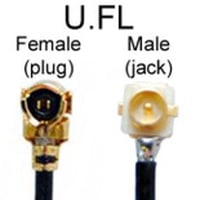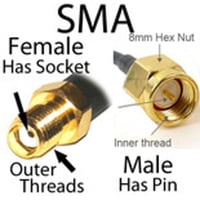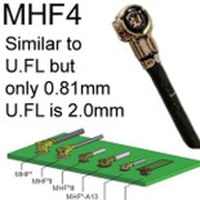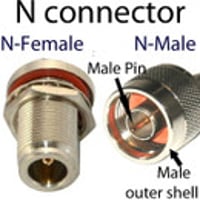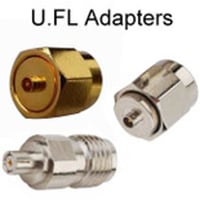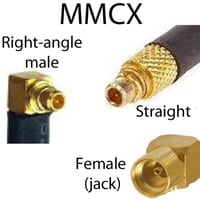U.FL to FME Cables
FME to U.FL Connector Antenna Cables
SEE LIST OF ARTICLES ABOUT U.FL CABLES AND CONNECTORS
The U.FL is a micro-coax connector made for micro-coax only such 1.13 coaxial cable and is often used as an embedded connector inside a device. U.FL is also known as Ultra Miniature Coax Connectors (UMCC)
U.FL cables connect antennas to the circuit board of Bluetooth beacons, RFID and IOT (Internet of Things) devices, which are smaller, lighter, and thinner.require connectors that not only have an extremely low mating height to fit in their small profile but also ones that will can be easily mated to the jack, and unmated if necessary. FME cables, adapters and connectors are typically used in cellular data applications. FME-Male is usually nickel plated brass and features a thread on the inside of the barrel and a pin. FME-Female, on the other hand, is long with a thread on the outside of the barrel and with a white nipple extending from the base of the connector.
1.13mm coaxial cable characteristics
1.13 coax cable has a very small diameter (1.13mm) and extreme flexibility, which makes it a useful part of IoT wireless, WiFi, WLAN, cellular communication and GPS set-ups.
1.32mm coaxial cable characteristics:
Shielded version similar to 1.13 coax1.32mm coaxial cable is a type of shielded electrical cable or transmission line designed to carry radiofrequency or electrical signals with minimal loss. 1.32mm denotes the diameter of the cable, typically plus or minus 0.05mm
Originally designed and patented by the physicist Oliver Heaviside in 1880, it comprises an inner conducting wire surrounded by insulation and an outer conducting metallic shield which works to block signal interference. These cables are known for their transmission efficiency and only rarely have signal leakage, known as egress, which may cause a snowy or fuzzy signal or tiling of images.
It is a generic and relatively inexpensive product which has a wide variety of applications where radio frequency energy needs to be effectively transmitted. Coax cables offer specific impedance of 50, 75 and even 95 Ohms depending on use.
U.FL connectors / Antenna cables w/ U.FL connectors
The Hirose U.FL connector is a type of radio frequency (RF) connector used to connect coaxial cables. It is the smallest RF connector on the market.
- U.FL (sometimes called UMCC) is rated up to 6Ghz.
A U.FL connection stands only 2.5mm high when mated. The small profile and right-angle joint make it ideal for applications where space is at a premium - FOR EXAMPLE: to connect a Wi-Fi antenna to a miniPCI card inside a slimline laptop.
- A U.FL cable may also connect to a GPS antenna or a Bluetooth Beacon.
Befitting a part that might end up in the chassis of a laptop, this connection is meant to stay put when mated. Snapping and unsnapping it several times will cause the female connector to wear out. It would then need to be replaced, along with the attached coaxial cable.
The male connector is usually soldered directly onto the circuit board as the jack: The jack is small enough to take up as little as 9mm x 9mm of space. The female connector snaps onto the male connector, secured by pressure from the metal snap structure.
A U.FL cable is typically a double-shielded 1.32mm coax. To fit in tight spaces, a thin and flexible 1.13mm coaxial cable may also be used. The largest antenna cable to feature U.FL is the 3mm RG-174. Thicker but still flexible, the RG174 coax is not double-shielded and delivers less signal loss than its 1.32mm or 1.13mm counterparts.

